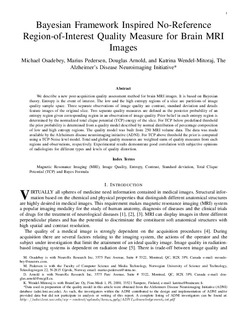| dc.contributor.author | Osadebey, Michael | |
| dc.contributor.author | Pedersen, Marius | |
| dc.contributor.author | Arnold, Douglas | |
| dc.contributor.author | Wendel-Mitoraj, Katrina | |
| dc.contributor.author | Neuroimaging Initiative, The Alzheimer’s Disease | |
| dc.date.accessioned | 2017-11-09T13:00:12Z | |
| dc.date.available | 2017-11-09T13:00:12Z | |
| dc.date.created | 2017-07-26T10:20:18Z | |
| dc.date.issued | 2017 | |
| dc.identifier.citation | Journal of Medical Imaging. 2017, 4 (2), 025504-1-025504-16. | nb_NO |
| dc.identifier.issn | 2329-4302 | |
| dc.identifier.uri | http://hdl.handle.net/11250/2465271 | |
| dc.description.abstract | We describe a postacquisition, attribute-based quality assessment method for brain magnetic resonance imaging (MRI) images. It is based on the application of Bayes theory to the relationship between entropy and image quality attributes. The entropy feature image of a slice is segmented into low- and high-entropy regions. For each entropy region, there are three separate observations of contrast, standard deviation, and sharpness quality attributes. A quality index for a quality attribute is the posterior probability of an entropy region given any corresponding region in a feature image where quality attribute is observed. Prior belief in each entropy region is determined from normalized total clique potential (TCP) energy of the slice. For TCP below the predefined threshold, the prior probability for a region is determined by deviation of its percentage composition in the slice from a standard normal distribution built from 250 MRI volume data provided by Alzheimer’s Disease Neuroimaging Initiative. For TCP above the threshold, the prior is computed using a mathematical model that describes the TCP–noise level relationship in brain MRI images. Our proposed method assesses the image quality of each entropy region and the global image. Experimental results demonstrate good correlation with subjective opinions of radiologists for different types and levels of quality distortions. | nb_NO |
| dc.language.iso | eng | nb_NO |
| dc.publisher | Society of Photo-optical Instrumentation Engineers (SPIE) | nb_NO |
| dc.title | Bayesian framework inspired no-reference region-of-interest quality measure for brain MRI images | nb_NO |
| dc.type | Journal article | nb_NO |
| dc.type | Peer reviewed | nb_NO |
| dc.description.version | acceptedVersion | nb_NO |
| dc.source.pagenumber | 025504-1-025504-16 | nb_NO |
| dc.source.volume | 4 | nb_NO |
| dc.source.journal | Journal of Medical Imaging | nb_NO |
| dc.source.issue | 2 | nb_NO |
| dc.identifier.doi | 10.1117/1.JMI.4.2.025504 | |
| dc.identifier.cristin | 1483111 | |
| dc.relation.project | Norges forskningsråd: 247689 | nb_NO |
| dc.description.localcode | Copyright 2017 Society of Photo Optical Instrumentation Engineers (SPIE). One print or electronic copy may be made for personal use only. Systematic reproduction and distribution, duplication of any material in this publication for a fee or for commercial purposes, or modification of the contents of the publication are prohibited. This is the authors' accepted and refereed manuscript to the article. | nb_NO |
| cristin.unitcode | 194,18,21,70 | |
| cristin.unitname | Norwegian Media Technology Lab | |
| cristin.ispublished | true | |
| cristin.fulltext | postprint | |
| cristin.qualitycode | 1 | |
